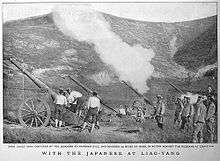42-line fortress and siege gun Pattern of 1877
| 42-line siege gun M1877 | |
|---|---|
|
M1877 in Hämeenlinna Artillery Museum. | |
| Type | siege gun |
| Place of origin |
German Empire Russian Empire |
| Production history | |
| Designer | Krupp |
| Designed | 1880 |
| Produced | ?-1903 |
| Specifications | |
| Weight | 2,500 kg (5,500 lbs) |
| Barrel length |
L/24 : 24 calibres 12.30 ft (3.75 m)[1] |
|
| |
| Caliber | 4.2 inch (106.7 mm) |
| Breech | Horizontal sliding block |
| Carriage | wheeled siege carriage, box trail |
| Muzzle velocity | 543 m/s (1,781 ft/s) |
| Maximum firing range | 9,600 m (10,500 yds) |
42-line fortress and siege gun M1877 (Russian: 42-линейная крепостная и осадная пушка образца 1877 года) was a siege gun used by the Russian Imperial Army in late 19th and early 20th centuries. The word "line" in the designation refers to a measurement unit which equals 0.1 inch. Curiously, the "model year" was not the year when the weapon was designed or standardized, but the year when a new rifling system was adopted.
History

The gun was initially developed by the German arms manufacturer Krupp and was based on an earlier 105 mm piece and would have a typical Krupp horizontal sliding wedge breech block.[2] The 105 mm weapon was demonstrated to a group of Russian Army officers along with a 120 mm design. The delegation liked the 105 mm weapon, but wanted Krupp to change the caliber to a traditional Russian caliber of "42 lines" (106.7 mm). Later the weapon entered production in Russia; it remained in production until 1903.
The 42-line siege gun M1877 could fire high explosive (HE) or shrapnel shells of 15.6 kg (34.3 lbs) weight at a distance of 9.6 km (6 miles).[3][4]
Notice in the image on right top of page the equipment around wheels used to reduce recoil.
Employment
The gun saw action in the Russo-Japanese War like in the defense of the Nanshan Hill during the battle of Nanshan. The Japanese Army successfully attacked the hill and captured several 42-line siege guns. Due to the lack of heavy artillery the Japanese took the guns in service during the rest of the conflict.
Montenegro used a few guns of this type up to World War I and Finland used weapons of this type until the World War II Era. Many of the 42-line siege guns were captured by the Imperial German Army and reissued to nine Landwehr Foot Artillery Battalions, equipping 22 Batteries.[5]
The 42-line siege gun M1877 should not be confused with the 42-line field gun M1877, a field gun version which had a shorter barrel and lower muzzle velocity.
Literature
- Shirokorad A. B. - Encyclopedia of the Soviet Artillery - Mn. Harvest, 2000 (Широкорад А. Б. Энциклопедия отечественной артиллерии. — Мн.: Харвест, 2000., ISBN 985-433-703-0)
External links
| Wikimedia Commons has media related to 107 mm siege gun M1877. |
- Images of a 42-line siege gun M1877
- JAEGER PLATOON: FINNISH ARMY 1918 - 1945 WEBSITE. ARTILLERY PART 1: Russian guns without recoil system
References
- ↑ "Allied Artillery of World War One". Retrieved 11 November 2014.
- ↑ "Website about a 42-line siege gun M1877". Retrieved 11 November 2014.
- ↑ "JAEGER PLATOON: FINNISH ARMY 1918 - 1945 WEBSITE. ARTILLERY PART 1: Russian guns without recoil system". Retrieved 11 November 2014.
- ↑ "Allied Artillery of World War One". Retrieved 11 November 2014.
- ↑ "Website about a 42-line siege gun M1877". Retrieved 11 November 2014.